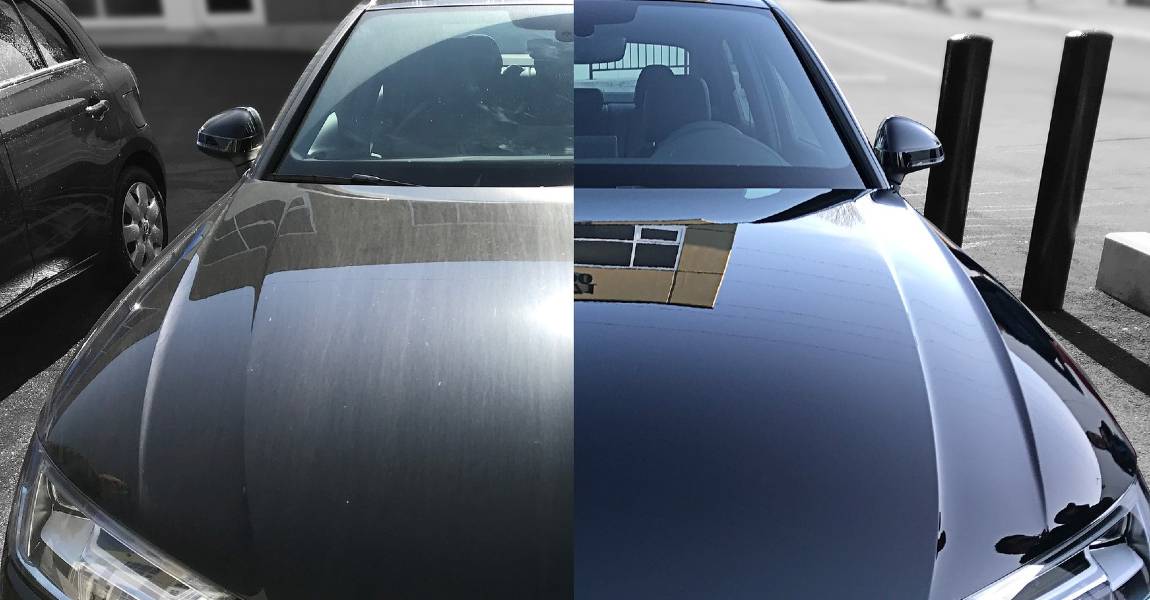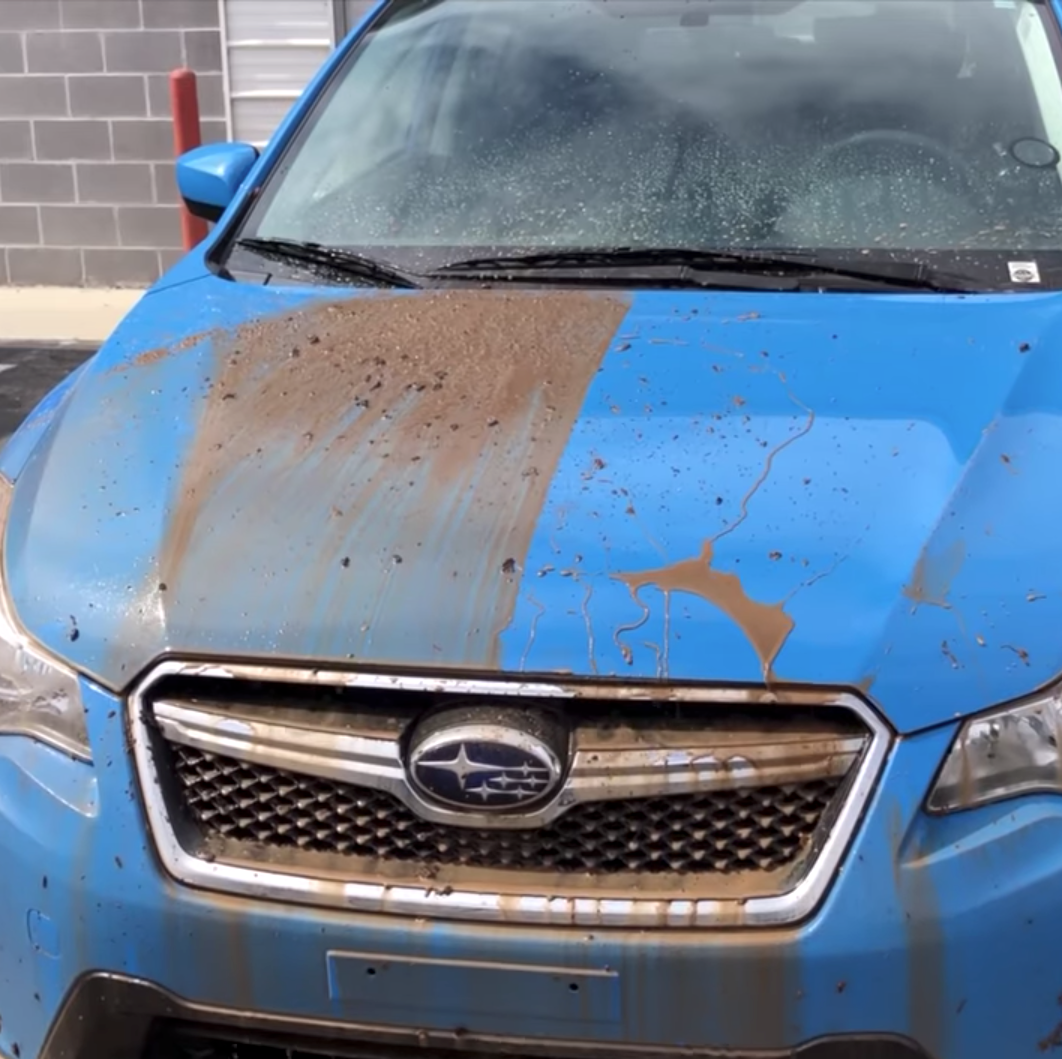Discovering the Scientific Research Behind Car Ceramic Coating and Its Safety Residences
The scientific research of car ceramic coating provides a remarkable research study in advanced vehicle defense. Made up mostly of silicon dioxide and polymers, these finishes develop a robust bond with lorry paint. This interaction boosts resilience against ecological dangers while offering hydrophobic benefits. Nevertheless, the complexities of how these layers work and their long-lasting advantages continue to be much less comprehended. Unpacking these information reveals why ceramic coatings are becoming a preferred choice for car care
What Is Ceramic Coating?
Ceramic coating is a liquid polymer that chemically bonds to the surface of an automobile's paint. This innovative safety layer enhances sturdiness and supplies exceptional resistance to ecological elements. Unlike standard wax or sealants, which give temporary protection, ceramic finishings create a durable guard that can endure extreme problems such as UV rays, acidic pollutants, and extreme weather condition. When applied appropriately, the coating forms a hydrophobic surface area, causing water to bead and slide off, which helps in maintaining the car's tidiness. Additionally, it offers improved gloss and depth to the paint, making the lorry show up even more polished and vibrant. The application procedure typically entails extensive surface area preparation, including cleansing and polishing, to assure peak bonding. Because of this, ceramic finishes are ending up being significantly prominent amongst car enthusiasts and those looking for to secure their financial investments, assuring to keep the car's aesthetic allure while decreasing the frequency of maintenance.
The Composition of Ceramic Coatings
The intricate formulation of ceramic coverings mainly includes silicon dioxide (SiO2), which is originated from all-natural resources like quartz and sand. This crucial element provides the structure for the coating's toughness and safety qualities. In addition to SiO2, ceramic coverings frequently consist of numerous polymers and additives that improve bond, flexibility, and resistance to environmental aspects. These substances work synergistically to create a robust obstacle versus impurities such as dirt, chemicals, and UV rays.Furthermore, some solutions incorporate titanium dioxide (TiO2) or various other nanomaterials, which can augment the coating's hydrophobic homes, causing improved water repellency. The precise structure can differ considerably amongst suppliers, affecting performance and long life. Ultimately, the combination of these components culminates in a protective layer that not just boosts the visual allure of lorries yet also offers to extend their life expectancy by protecting the surface from potential damages.
Exactly How Ceramic Coatings Job
Comprehending how ceramic finishes function entails discovering their chemical structure, which adds to their safety high qualities. The application procedure is necessary for attaining perfect results, while durability and resilience aspects determine the coating's performance in time. With each other, these components highlight the advantages and performance of ceramic coatings for lorry security.
Chemical Structure Explained
While numerous car owners look for resilient defense for their cars, the chemical structure of ceramic coatings plays a vital duty in their effectiveness. These finishings largely include silicon dioxide (SiO2), which is originated from natural minerals. This compound develops a strong bond with the automobile's paint, developing a sturdy, protective layer. Furthermore, lots of ceramic layers include titanium dioxide (TiO2), boosting their hydrophobic properties and resistance to UV rays. The existence of polysiloxanes can even more improve adaptability and toughness. Together, these elements add to the coating's capability to fend off water, dirt, and pollutants, while also offering a high-gloss finish. Comprehending this chemical structure assists car proprietors value the robust protection used by ceramic finishes.
Application Refine Overview
Applying ceramic finishes entails a meticulous process that assures ideal bonding and security for the automobile's surface area. At first, detailed cleaning and decontamination of the car's outside are carried out to eliminate dirt, crud, and previous waxes. This action validates that the surface is cost-free from impurities that can prevent attachment. Following this, the paint is frequently polished to improve quality and remove any kind of flaws. Once prepared, the ceramic coating is used in tiny areas using an applicator pad, enabling for uniform coverage. The coating is after that left to heal, creating a solid chemical bond with the surface. Correct treating times and conditions are essential, as they confirm the coating attains its maximum performance and protective top qualities.
Longevity and Durability Aspects
Ceramic coatings are created to provide resilient protection with their innovative chemical composition, which produces a durable barrier versus ecological contaminants. The resilience of these coverings is influenced by variables such as the density of the application, the top quality of the item, and the conditions under which the car is revealed. Premium ceramic layers can last numerous years, standing up to scrapes, UV rays, and chemical spots. Appropriate maintenance, including normal washing and routine reapplication, can even more boost durability. Additionally, ecological factors like climate and direct exposure to contaminants can impact the life expectancy of the coating. Overall, when used and maintained properly, ceramic finishes provide extraordinary sturdiness, making them a popular selection for car lovers seeking to preserve their vehicle's look.
Hydrophobic Characteristics and Water Repellency
Hydrophobic residential properties are a trademark of high quality car ceramic finishings, substantially boosting the automobile's surface efficiency. These coverings produce a molecular bond with the car's paint, causing a surface that drives away water efficiently. When water comes right into contact with a ceramic-coated surface, it grains up and rolls off, reducing the quantity of fluid that continues to be on the paint. This actions not just adds to an aesthetically pleasing look however likewise decreases the build-up of contaminants such as dust, grime, and roadway salts.The improved water repellency causes less complicated cleansing and maintenance, as much less effort is required to get rid of unwanted materials. Additionally, the hydrophobic nature of ceramic finishes helps in stopping water spots, which can mar the finish of uncoated surface areas. On the whole, the unification of hydrophobic homes in ceramic finishings plays a necessary duty in preserving the click over here now automobile's beautiful look while simplifying maintenance.
Defense Against Scratches and UV Damage
Car ceramic coverings provide significant protection versus scrapes and UV damages. The scratch resistance mechanism produces a long lasting layer that takes in influences, while the UV securing advantages aid preserve the vehicle's paint honesty gradually. Together, these features add to a longer-lasting and visually enticing coating.
Scrape Resistance Mechanism
Utilizing sophisticated modern technology, ceramic finishes offer a robust guard versus scratches and UV damages, improving the longevity and look of car surface areas. The scratch resistance device of these finishings is credited to their unique molecular structure, which creates a durable bond with the automobile's paint. This bond creates a hard, protective layer that can soak up impacts and withstand abrasions. In addition, the smooth surface area of the coating reduces rubbing, making it challenging for pollutants to adhere and create scratches. The chemical composition of ceramic finishings usually includes nanoparticles that reinforce the protective layer, more enhancing its resilience. Cars treated with ceramic coverings exhibit markedly boosted scratch resistance contrasted to standard wax or sealants, ensuring a beautiful surface over time.
UV Shielding Advantages
The protective high qualities of ceramic coatings extend beyond scratch resistance to include considerable UV securing benefits. These layers create a robust barrier that shows damaging ultraviolet rays, guarding the lorry's paint and underlying materials. Prolonged exposure to UV radiation can bring about fading, oxidation, and degeneration of the paint finish. By incorporating ceramic coverings, lorry owners can successfully minimize these risks, preserving the see it here aesthetic charm and integrity of their cars. In addition, the UV obstructing properties contribute to boosted long life, lowering the frequency of painting and upkeep. Eventually, the integration of ceramic coatings supplies an extensive solution for protecting automobiles from the harmful impacts of sun exposure, ensuring a continual, dynamic look gradually.
The Long life and Maintenance of Ceramic Coatings

Often Asked Questions
Can Ceramic Coating Be Applied to Any Type Of Sort Of Car?
Ceramic coating can be used to numerous sorts of lorries, consisting of vehicles, trucks, and bikes. Nonetheless, surface area prep work and compatibility with particular products are necessary for excellent adhesion and performance of the coating.
How Much Does Ceramic Coating Typically Price?
Ceramic coating commonly sets you back between $500 and $2,000, relying on factors such as lorry size, coating high quality, and expert application. The financial investment can provide long-lasting defense and enhance the vehicle's look in time.

Is Expert Application Necessary for Ideal Outcomes?
The need of professional application usually depends on wanted results. Specialists usually guarantee proper surface area preparation and application strategies, causing excellent bonding and durability of the coating, which may be testing for inexperienced people to attain.
Can Ceramic Coatings Be Removed or Repaired?
Ceramic finishes can be gotten rid of or fixed, though the procedure may require particular solvents or techniques - Ceramic Coating Newark. Proper removal is necessary to stay clear of damage to the underlying surface, emphasizing the significance of professional support for ideal outcomes
Exactly How Does Porcelain Coating Compare to Standard Wax?
The contrast in between ceramic coating and standard wax reveals that ceramic coatings provide exceptional sturdiness, enhanced defense versus environmental pollutants, and longer-lasting shine, while wax needs much more frequent application and offers much less overall resistance to damages.